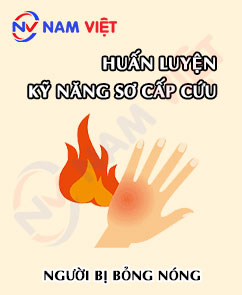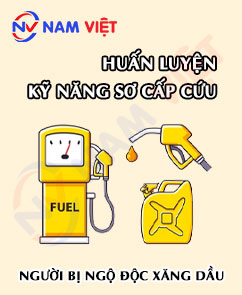First aid training for individuals who have fallen from a height
500,000 ₫
Note: The above price is calculated per person. Prices may vary depending on the number of participants in the course and market fluctuations. For more accurate pricing, please refer to the price list or contact our consulting staff directly.
Table of Contents
Toggle1. Identifying a High Fall Victim
a. Cases of high fall incidents
A high-fall incident occurs when a person falls from a height, typically over 1.5 meters. Such falls can cause serious injuries, including fractures, head trauma, spinal injuries, internal organ damage, and external wounds. Without timely care, these injuries may lead to life-threatening complications.
Causes of high-fall incidents include improper use of safety equipment, jumping from heights, climbing trees or walls, operating equipment at height, and slipping.

b. Signs someone is about to fall from a height
Signs that a person may be at risk of a high fall include:
- Loss of balance, staggering, dizziness, or lightheadedness
- Feeling unfocused or mentally confused
- Loss of control over body movements
- Rapid heartbeat and nervousness
- Increased breathing rate or shortness of breath
- Sudden rise or drop in blood pressure
- Headache or dizziness when standing up from lying or sitting positions
If any of these signs are noticed, the person may be about to fall and requires immediate assistance.

c. Assessing the condition of a high-fall victim
The conditions of a high-fall victim may include:
- Head and cervical spine injuries: The victim may hit their head on the ground or a hard object, causing skull or neck trauma.
- Fractures: Bones, especially arms, legs, and spine, may break during the fall.
- Heart and lung injuries: High falls may result in cardiac or pulmonary trauma, potentially leading to heart or lung failure.
- Abdominal and chest injuries: The victim may strike hard objects, causing injuries to the abdomen or chest.
- Soft tissue injuries: Bruises or wounds may occur during the fall.
- Functional impairment: Injuries may reduce mobility or speech capability.
Depending on injury severity, the victim’s condition can be critical and requires prompt intervention to prevent serious consequences.

d. Golden time for high-fall cases
In high-fall incidents, the golden time for first aid is crucial. Without timely care, victims may suffer respiratory failure, thyroid issues, or cardiovascular complications.
The golden time depends on injury severity and type. However, if the victim loses consciousness or shows respiratory distress, call emergency number 115 immediately and transfer the victim to a hospital as quickly as possible.
If the victim is conscious but shows abnormal signs such as headache, fatigue, nausea, or dizziness, have them rest, lie down, and keep their head lower than their body, for example by placing a pillow under their head. If necessary, use bandages to stabilize injuries.
At the same time, call emergency services to arrange hospital transfer. While waiting for the ambulance, keep the victim still and provide psychological support.
2. Overview of First Aid Training for High Fall Victims
a. What is a first aid training course?
A first aid training course teaches both basic and advanced first aid skills. It includes lessons and practical exercises on handling emergencies such as cardiac arrest, respiratory failure, poisoning, injuries, and other urgent situations.
The course equips learners with the skills to respond effectively to emergencies, minimize harm to themselves and others, increase survival chances, and ensure timely transfer to medical facilities.
REGISTER FOR BASIC FIRST AID TRAINING
b. Training duration
Initial first aid training:
- For employees: 4 hours.
- For first aid and emergency responders: 16 hours (2 days).
Periodic first aid training:
- For employees: 2 hours.
- For first aid and emergency responders: 8 hours (1 day).
c. Course content
- Basic principles of first aid and on-site emergency care
- Wound bandaging (principles, tools, techniques)
- Temporary bleeding control techniques (principles and methods)
- Temporary fracture stabilization techniques (principles and tools)
- Cardiopulmonary resuscitation (recognizing signs of cardiac arrest, airway clearance, breathing support, CPR guidance)
- Burn management (assessing cause and severity, on-site first aid)
- Safe victim transportation with and without stretchers for initial care
- Specific emergency care scenarios:
- Electric shock
- Drowning
- Chemical accidents
- General guidance on first aid kit use
- Practical exercises for all content areas
d. First aid training certificate
Upon completing the course, learners receive a certificate confirming completion of the first aid training program under the Group 2 training framework as specified in Appendix IV, Decree 44/2016/ND-CP. The certificate is valid for 1 year.


3. Essential Tools for a First Aid Kit in Case of a High Fall
The essential tools for a first aid kit for high fall incidents include:
- Bandages and dressings: Used to secure wounds and reduce pain for the victim.
- Neck support pillow: Used to support the victim’s neck and head during transport.
- Cloth with bandage pack: Used to clean and dress wounds.
- Medical adhesive tape: Used to bandage wounds and keep them clean.
- Medical gloves: Used to protect hands when in contact with the victim’s blood or fluids.
- Scissors: Used to cut clothing or belts if necessary.
- Saline solution: Used to rinse eyes or clean wounds.
- Ice pack or gel pack: Used to reduce pain or swelling.
- Cotton clamp: Used to apply pressure to bleeding vessels.
- Rescue mask: Used to provide oxygen if the victim has difficulty breathing.
- Flashlight: Used to illuminate the area if necessary.
- Carrying bag: Used to store first aid tools and make them easy to carry.
REGISTER FOR BASIC FIRST AID TRAINING
4. First Aid Procedure for High Fall Victims
The first aid procedure for high fall victims is as follows:
- Check the surrounding environment: First, ensure the area is safe for both yourself and the victim. If there is a risk of further falling or hitting hard objects, move the victim to a safer area.
- Assess the victim’s condition: Check if the victim is conscious by asking their name and address. If the victim is unconscious, check their breathing and pulse.
- Call emergency services: If the victim is unconscious, call emergency services immediately. If the victim is conscious and stable, take them to a hospital for a medical checkup and tests.
- Treat wounds: If the victim has injuries, use bandages or clean cloths to stop bleeding. For severe wounds, quickly transport the victim to a hospital.
- Ensure the victim’s safety: If the victim is unconscious or showing signs of shock, keep them warm and calm. Do not give them any medications, alcohol, or tobacco.
- Monitor the victim: Observe and record the victim’s symptoms and condition to provide accurate information to the rescue team upon arrival.
Note: If the victim shows signs of unconsciousness or cardiac arrest, start CPR immediately and call emergency services.
5. Benefits of First Aid Training
First aid training provides many important benefits for individuals and the community:
- Saving lives in dangerous situations: First aid skills enable trainees to save people whose lives are at risk, such as cardiac arrest, respiratory arrest, poisoning, injuries, and other emergencies.
- Helping others learn first aid: Trained individuals can share their knowledge and experience, allowing the community to protect itself and reduce fatalities in emergency situations.
- Reducing waiting time for rescue: Trained first aiders can handle emergencies on-site, minimizing waiting time for rescue teams.
- Enhancing response and reducing stress in emergencies: First aid training helps learners respond accurately and quickly, reducing stress and anxiety while waiting for rescue.
- Increasing survival rates and reducing fatalities: Timely and proper first aid improves survival chances and reduces complications or deaths in emergencies.

6. First Aid Training Capacity of An Toan Nam Viet
An Toan Nam Viet is a reputable and high-quality first aid training center in Vietnam. Training sessions are conducted continuously at workshops, factories, and construction sites nationwide (all 63 provinces of Vietnam).
REGISTER FOR BASIC FIRST AID TRAINING
Training Certification
- An Toan Nam Viet has been inspected and certified by the Department of Safety under the Ministry of Labor – Invalids and Social Affairs for occupational safety and hygiene training. Within the Group 2 training program, the first aid skills module is included, further strengthening our capacity in first aid training.

Training Materials and Lectures
- Before being used in first aid courses, training materials are reviewed to ensure accuracy and practical effectiveness.
- Instructor methods are standardized according to An Toan Nam Viet standards, developed by experts in first aid training to maximize knowledge retention for learners.
Facilities
- Controlling factors in the training room enhances teaching efficiency and knowledge absorption.
- Our training facilities provide spacious classrooms meeting standards for space, lighting, and training equipment.
7. Nationwide First Aid Training Centers
An Toan Nam Viet is one of the most reputable and professional organizations for first aid training in Vietnam. With experienced instructors, modern equipment, and high-quality programs, the center has become an ideal destination for those interested in protecting lives and health.
By attending courses at An Toan Nam Viet, you will learn basic and advanced first aid skills, from CPR for cardiac arrest, respiratory arrest, poisoning, injuries, to handling other emergency situations. The program is flexible and suitable for all learners, including adults, children, medical staff, rescue personnel, and the general public.
An Toan Nam Viet’s first aid training not only teaches essential life-saving skills but also fosters awareness to protect your own life and health as well as those around you. Training by experienced and highly qualified instructors ensures confidence and readiness for any emergency situation.
Register for first aid courses at An Toan Nam Viet to protect your life, health, and the community.
1 review for First aid training for individuals who have fallen from a height
No comments yet












phanminhhang341
Very good and professional first aid training unit